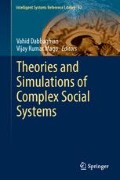Abstract
Social Network Change Detection (SNCD) algorithm is applied to detect abrupt change in political networks of Sudan. In particular, SNCD compares the longitudinal normalized network-level measures against a predetermined threshold value. These measures are density, average closeness, and average betweenness over different time periods. Data extracted from Sudan Tribune in 2003–2008 is presented in a form of yearly two-mode networks of agents and organizations. The result shows that SNCD detects abrupt changes that correspond to actual historical events. In particular, the analysis shows that the foreign-brokered signings of multiple peace agreements served as a political solidification point for political actors of Sudan. This was a catalyst that caused three leaders to have emerged and lead the more compartmentalized yet faction-cohesive political networks of Sudan.
Access this chapter
Tax calculation will be finalised at checkout
Purchases are for personal use only
Notes
- 1.
For a detailed derivation of SNCD method, readers should consult McCulloh and Carley’s [21] paper.
References
BBC News: Darfur war crime suspect profiles. BBC News. http://news.bbc.co.uk/2/hi/africa/4946986.stm (2006). Accessed 20 July 2010
BBC News: Q &A: Sudan’s Darfur crisis. BBC News. http://news.bbc.co.uk/2/hi/africa/3496731.stm (2009). Accessed 28 Jan 2010
BBC News: South Sudan’s flag raised at independence ceremony. BBC News. http://www.bbc.co.uk/news/world-africa-14092375 (2011). Accessed 18 Sept 2012
BBC News: Sudan denies Darfur Militia ties. BBC News. http://news.bbc.co.uk/2/hi/africa/3908645.stm (2004). Accessed 28 Jan 2010
BBC WorldService: President Omar Al-Bashir re-elected in Sudan elections. BBC World Service. http://www.bbc.co.uk/worldservice/news/2010/04/100426_sudan_elections_hs.shtml (2010). Accessed 29 June 2010
Bonacich, P., Oliver, A., Snijders, T.A.B.: Controlling for size in centrality scores. Soc. Netw. 20, 135–141 (1998)
CNN: Sudanese President charged with Genocide. CNN. http://www.cnn.com/2008/WORLD/africa/07/14/darfur.charges/ (2008). Accessed 28 Jan 2010
Coleman, T.F., Moré, J.J.: Estimation of sparse Jacobian matrices and graph coloring problems. SIAM J. Numer. Anal. 20, 187–209 (1983)
Diesner, J., Carley, K.M., Tambayong, L.: Mapping socio-cultural networks of Sudan from open-source, large-scale text data. Comput. Math. Organ. Theory 18(3), 328–339 (2012) (Special Issue: Data to Model)
Doreian, P.: On the evolution of group and network structures II: structures within structure. Soc. Netw. 8, 33–64 (1983)
Doreian, P., Frans, N. (eds.): Evolution of Social Networks. Gordon and Breach, Netherland (1997)
Frank, O.: Statistical analysis of change in networks. Stat. Neerl. 45, 283–293 (1991)
Freeman, L.C.: A set of measures of centrality based on betweenness. Sociometry 40, 35–41 (1977)
Freeman, L.C.: Centrality in social networks I: conceptual clarification. Soc. Netw. 1, 215–239 (1979)
Holland, P., Leinhardt, S.: A dynamic model for social networks. J. Math. Sociol. 5, 5–20 (1977)
Huisman, M., Snijders, T.A.B.: Statistical analysis of longitudinal network data with changing composition. Sociolog. Methods Res. 32, 253–287 (2003)
Katz, L., Proctor, C.H.: The configuration of interpersonal relations in a group as a time-dependent stochastic process. Psychometrika 24, 317–327 (1959)
Kelle, U.: Theory building in qualitative research and computer programs for the management of textual data. Sociolog. Res. Online 2, 2 (1997)
Malek, C.: The Darfur region of Sudan. http://www.beyondintractability.org/case_studies/Darfur.jsp?=5101 (2005). Accessed 29 Jan 2010
McCrummen, S.: A town constantly on brink of chaos. The Washington Post. http://www.washingtonpost.com/wp-dyn/content/article/2009/04/24/AR2009042403746.html (2009). Accessed 28 Jan 2010
McCulloh, I., Carley, K.M.: Detecting change in longitudinal social networks. J. Soc. Stuct. 12, 3 (2011)
Popping, R.: Computer-Assisted Text Analysis. Sage, Thousand Oaks (2000)
Snijders, T.A.B.: Testing for change in a digraph at two time points. Soc. Netw. 12, 539–573 (1990)
Sowa, J.F.: Concept Structures: Information Processing in Mind and Machine. Addison-Wesley, Reading (1984)
Sudan Tribune: Sudan’s Bashir promotes Taha to first Vice-President and appoints a Darfurian as VP. Sudan Tribune. http://www.sudantribune.com/Sudan-s-Bashir-promotes-Taha-to,40146 (2011). Accessed 18 Sept 2012
Tambayong, L., Carley, K.M.: Political networks of Sudan: a two-mode dynamic network text analysis. J. Soc. Struct. 13, 2 (2012)
Tambayong, L.: The stability and dynamics of political networks of Sudan. J. Artif. Soc. Soc. Simul. (2013) (forthcoming)
Wasserman, S., Scott, J., Carrington, P.: Introduction. In: Carrington, P., Scott, J., Wasserman, S. (eds.) Models and Methods in Social Network Analysis. Cambridge Press, Cambridge (2007)
Wasserman, S.: Stochastic Models for Directed Graphs. Ph.D. Dissertation, Harvard University, Department of Statistics, Cambridge, MA (1977)
Wasserman, S.: Analyzing social networks as stochastic processes. J. Am. Stat. Assoc. 75, 280–294 (1980)
Wasserman, S., Iacobucci, D.: Sequential social network data. Psychometrika 53, 261–282 (1988)
Wasserman, S., Faust, K.: Social Network Analysis: Methods and Applications. Cambridge University Press, New York (1994)
White, D.R., Tambayong, L., Kejžar, N.: Oscillatory dynamics of city-size distributions in world historical systems. In: Modelski, G., Devezas, T., Thompson, W. (eds.) Globalization as Evolutionary Process: Modeling, Simulating, and Forecasting Global Change. Routledge, London (2008)
White, D.R., Tambayong, L.: City system vulnerability and resilience: oscillatory dynamics of urban hierarchies. In: Dabbaghian, V., Mago, V. (eds.) Modelling and Simulation of Complex Social System. Springer, New York (2013)
U.S. Department of State: Sudan country reports on terrorism 2008, Chapter 3: State sponsors of terrorism. U.S. Department of State Office of the Coordinator for Counterterrorism. http://www.state.gov/s/ct/rls/crt/2008/122436.htm (2009). Accessed 16 Feb 2010
Acknowledgments
This work is partly funded under a MURI—grant number N00014-08-1-1186 (Kathleen M. Carley, P.I.). The views and conclusions contained in this document are those of the authors and should not be interpreted as representing the official policies, either expressed or implied, of the Office of Naval Research, or the U.S. government. I am also grateful for generous advice and thoughts from Jeffrey C. Johnson and Richard A. Lobban.
Author information
Authors and Affiliations
Corresponding author
Editor information
Editors and Affiliations
Rights and permissions
Copyright information
© 2014 Springer-Verlag Berlin Heidelberg
About this chapter
Cite this chapter
Tambayong, L. (2014). Change Detection in Dynamic Political Networks: The Case of Sudan. In: Dabbaghian, V., Mago, V. (eds) Theories and Simulations of Complex Social Systems. Intelligent Systems Reference Library, vol 52. Springer, Berlin, Heidelberg. https://doi.org/10.1007/978-3-642-39149-1_5
Download citation
DOI: https://doi.org/10.1007/978-3-642-39149-1_5
Published:
Publisher Name: Springer, Berlin, Heidelberg
Print ISBN: 978-3-642-39148-4
Online ISBN: 978-3-642-39149-1
eBook Packages: EngineeringEngineering (R0)

